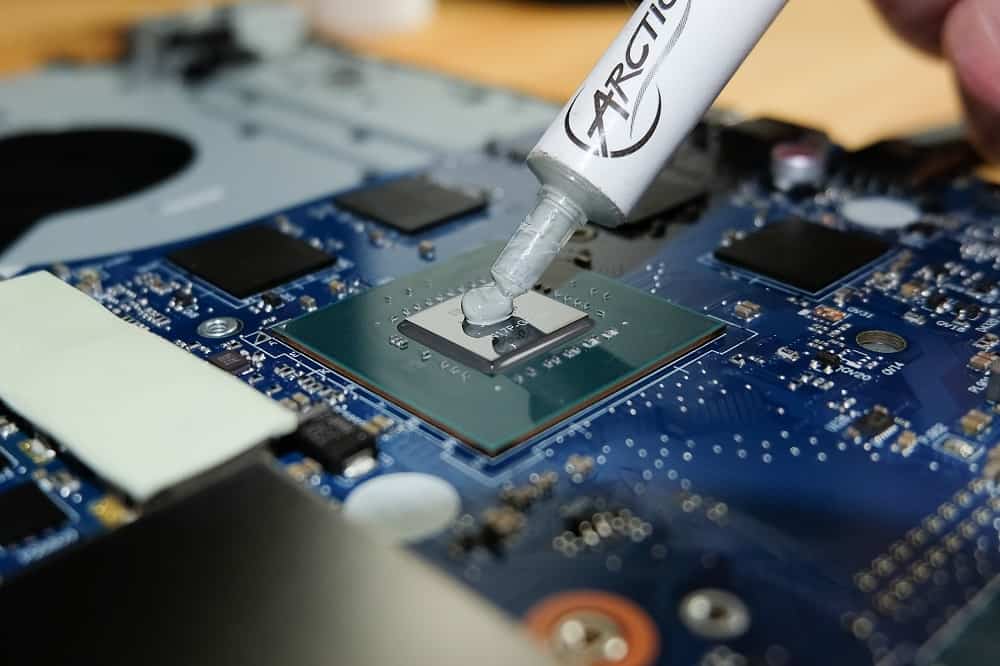Components such as power transistors, Central Processing Units (CPUs), and Graphics Processing Units (GPUs) generate heat that needs to be effectively dissipated, otherwise the component can undergo thermal runaway and/or throttling, with the possibility of it eventually leading to catastrophic failure.
To date, the most popular and effective solution in helping dissipate this heat, is through the use of a heatsink, often coupled with a cooling fan.
CPUs and GPUs are produced with a metallic Integrated Heat Spreader (IHS) physically bonded to the die on which all the circuitry has been fabricated. Heatsinks have a baseplate (or in the case of liquid coolers, a water block), that is directly attached to the IHS of the CPU or GPU.
At the microscopic level, there are small imperfections on both surfaces, that leave air gaps when the two surfaces are joined. In this case, air acts like an insulator and the gaps can greatly reduce the amount of heat dissipated.
A thermal interface material (TIM) is hence used to fill in the gaps. TIM is sometimes more commonly referred to as thermal paste, but also as thermal compound, heat sink compound, and heat paste.
What is Thermal Paste?
Thermal paste is a chemical compound that fills any air gaps between two surfaces that are mechanically coupled. When applied between the IHS of a CPU and a heatsink baseplate, the thermal paste increases the thermal coupling between the two, and heat is more efficiently transferred away from the CPU and to the heatsink, where it can be appropriately dissipated.

The two main components in thermal paste are a polymer base, commonly called a matrix, and a liquid or micronized metal filler. Most, common thermal pastes use silicone as the polymer base, which does not have a high thermal conductivity, and so also incorporate a metal filler, such as zinc oxide (gives a white color), aluminum oxide or nitrite, or pulverized silver (silver color).
The metal filler therefore, is what gives the thermal paste its thermal conductivity. Some high end thermal pastes are composed of almost entirely metal filler, but this can make the thermal paste electrically conductive and can cause damage if it flows onto any surrounding components and circuits.
Thermal conductivity is measured in Watts per meter Kelvin (W/mK). This defines the number of Watts conducted per meter thickness of the material, per degree of temperature difference between the two surfaces.
In the case of thermal paste applied between an IHS and heatsink, the higher the thermal conductivity, the better. A decent thermal paste will provide a thermal conductivity of 5 W/mK and upwards, with high end thermal pastes starting at 8 W/mK.
Other than thermal paste, also available are thermal pads offering a thermal conductivity of 3 to 14 W/mK, and there are even thermal compounds based on a variety of liquid metals with a thermal conductivity of 20 to 40 W/mK.
Compare these figures with aluminum, which has a thermal conductivity of 205 W/mK, and copper with 400 W/mK. This shows that thermal pastes, pads, and liquid metal compounds are not as good heat conductors as solid metals.
For this reason, it is recommended to apply only a very thin layer of thermal paste, sufficient to fill in any microscopic air gaps.
As one manufacturer puts it:
“as little as possible and as much as necessary, so that the heat-conducting paste completely fills the unevenness between component and cooler, but does not increase the distance between the two bodies.”
Mueller Ahlhorn
Some other characteristics to keep in mind with thermal paste are the working or continuous use temperature range, viscosity, and breakdown voltage. Typical values for these are a temperature range of -40 °C to +200 °C, a breakdown voltage of 250V/mm and viscosity of 500 poise.
Breakdown voltage is the minimum voltage over a distance that causes a material to become electrically conductive. It is usually expressed as volts per millimeter (V/mm). The higher the breakdown voltage, the less electrically conductive a paste will be. Some thermal pastes claim to have no electrical conductivity at all.
Viscosity refers to how much resistance to motion a fluid offers under an applied force. With respect to thermal paste, there are differences from brand to brand, with some pastes tending toward liquid, while others toward a thicker paste.
This does not make one thermal paste better than another, although each may be more suitable for a particular use. Viscosity coupled with density (some manufacturers also include this in their specifications and is measured in grams per cubic centimeter), indicate the consistency and smoothness of a thermal paste, and how easily it spreads.
The fundamental unit of measurement for viscosity is the poise. A material requiring a shear stress of one dyne per square centimeter to produce a shear rate of one reciprocal second has a viscosity of one poise. Viscosity is also measured in Pascal-seconds (Pa s). One Pascal-second is equal to ten poise.
Does Thermal Paste Expire?
Typically, thermal paste has a shelf life in its container, of 3 to 5 years, as long as the container is maintained unopened and stored in a cool place away from sunlight. Once opened, it depends on the composition of the compound, in which case, it’s usually best to consult the manufacturer specifications.

Once applied, some thermal pastes cure after the initial 100 hours or so of use, when high temperatures have been applied. Furthermore, some thermal pastes also tend to harden over the years. In many cases, this is quite normal and does not mean that the paste needs to be replaced, unless the component being cooled has displayed decreased heat dissipation efficiency.
Generally, thermal paste applied to the stock standard heatsink supplied with and installed on a CPU or GPU by the manufacturer, as in the case of a laptop, will rarely need to be replaced during the lifetime of the laptop. With a custom built system however, especially one that is overclocked, this will depend on how well the thermal paste is applied and the quality of the paste used.
While thermal paste manufacturers provide specifications stating the usage time or durability of their product, which can typically range from 5 to 8 years, there may be a more prevalent degradation problem concerning thermal paste lifespan, called thermal paste pump out.
Pump out occurs when the CPU, GPU, power transistor, or any other device, undergoes rapid temperature fluctuations. The resulting expansion and contraction of the metal surfaces produces a pumping action which can, in the case of a CPU, squeeze thermal paste away from the center of the IHS, and toward the edges. Obviously, this will greatly reduce thermal transfer efficiency.
In conclusion, it is best to check the thermal paste specifications as to its suitability for the required use, and follow the manufacturer’s guidelines and recommendations. And the best indicator that the thermal paste may require replacing, is if CPU or GPU core temperatures are higher than normal.

